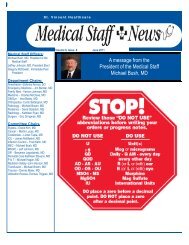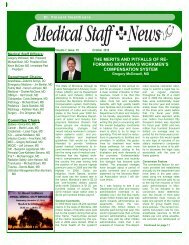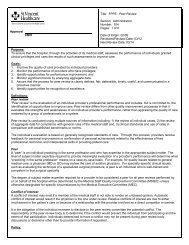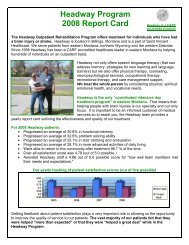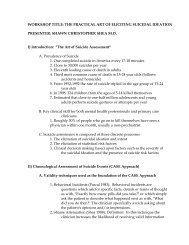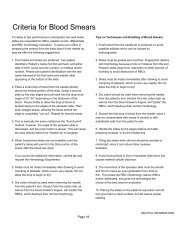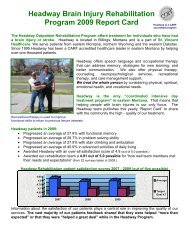AHA/ASA Guideline Guidelines for the Prevention of Stroke in ...
AHA/ASA Guideline Guidelines for the Prevention of Stroke in ...
AHA/ASA Guideline Guidelines for the Prevention of Stroke in ...
You also want an ePaper? Increase the reach of your titles
YUMPU automatically turns print PDFs into web optimized ePapers that Google loves.
272 <strong>Stroke</strong> January 2011375. Clarke R, Daly L, Rob<strong>in</strong>son K, Naughten E, Cahalane S, Fowler B,Graham I. Hyperhomocyste<strong>in</strong>emia: an <strong>in</strong>dependent risk factor <strong>for</strong>vascular disease. N Engl J Med. 1991;324:1149–1155.376. Boushey CJ, Beres<strong>for</strong>d SA, Omenn GS, Motulsky AG. A quantitativeassessment <strong>of</strong> plasma homocyste<strong>in</strong>e as a risk factor <strong>for</strong> vascular disease:probable benefits <strong>of</strong> <strong>in</strong>creas<strong>in</strong>g folic acid <strong>in</strong>takes. JAMA. 1995;274:1049–1057.377. Madonna P, de Stefano V, Coppola A, Cirillo F, Cerbone AM, OreficeG, Di M<strong>in</strong>no G. Hyperhomocyste<strong>in</strong>emia and o<strong>the</strong>r <strong>in</strong>herited prothromboticconditions <strong>in</strong> young adults with a history <strong>of</strong> ischemic stroke.<strong>Stroke</strong>. 2002;33:51–56.378. Wang X, Q<strong>in</strong> X, Demirtas H, Li J, Mao G, Huo Y, Sun N, Liu L, Xu X.Efficacy <strong>of</strong> folic acid supplementation <strong>in</strong> stroke prevention: a meta-analysis.Lancet. 2007;369:1876–1882.379. Lonn E, Yusuf S, Arnold MJ, Sheridan P, Pogue J, Micks M, McQueenMJ, Probstfield J, Fodor G, Held C, Genest J Jr. Homocyste<strong>in</strong>e lower<strong>in</strong>gwith folic acid and B vitam<strong>in</strong>s <strong>in</strong> vascular disease. N Engl J Med.2006;354:1567–1577.380. Toole JF, Mal<strong>in</strong>ow MR, Chambless LE, Spence JD, Pettigrew LC,Howard VJ, Sides EG, Wang CH, Stampfer M. Lower<strong>in</strong>g homocyste<strong>in</strong>e<strong>in</strong> patients with ischemic stroke to prevent recurrent stroke, myocardial<strong>in</strong>farction, and death: <strong>the</strong> Vitam<strong>in</strong> Intervention <strong>for</strong> <strong>Stroke</strong> <strong>Prevention</strong>(VISP) randomized controlled trial. JAMA. 2004;291:565–575.381. Hankey GJ, Eikelboom JW, van Bockxmeer FM, L<strong>of</strong>thouse E, StaplesN, Baker RI. Inherited thrombophilia <strong>in</strong> ischemic stroke and itspathogenic subtypes. <strong>Stroke</strong>. 2001;32:1793–1799.382. Ganesan V, McShane MA, Liesner R, Cookson J, Hann I, KirkhamFJ. Inherited prothrombotic states and ischaemic stroke <strong>in</strong> childhood.J Neurol Neurosurg Psychiatry. 1998;65:508–511.383. Koster T, Rosendaal FR, de Ronde H, Briet E, Vandenbroucke JP,Bert<strong>in</strong>a RM. Venous thrombosis due to poor anticoagulant response toactivated prote<strong>in</strong> C: Leiden Thrombophilia Study. Lancet. 1993;342:1503–1506.384. Svensson PJ, Dahlback B. Resistance to activated prote<strong>in</strong> C as a basis<strong>for</strong> venous thrombosis. N Engl J Med. 1994;330:517–522.385. L<strong>in</strong>dblad B, Svensson PJ, Dahlback B. Arterial and venous thromboembolismwith fatal outcome and resistance to activated prote<strong>in</strong> C.Lancet. 1994;343:917.386. Simioni P, de Ronde H, Prandoni P, Salad<strong>in</strong>i M, Bert<strong>in</strong>a RM, GirolamiA. Ischemic stroke <strong>in</strong> young patients with activated prote<strong>in</strong> C resistance:a report <strong>of</strong> three cases belong<strong>in</strong>g to three different k<strong>in</strong>dreds. <strong>Stroke</strong>.1995;26:885–890.387. Poort SR, Rosendaal FR, Reitsma PH, Bert<strong>in</strong>a RM. A common geneticvariation <strong>in</strong> <strong>the</strong> 3-untranslated region <strong>of</strong> <strong>the</strong> prothromb<strong>in</strong> gene is associatedwith elevated plasma prothromb<strong>in</strong> levels and an <strong>in</strong>crease <strong>in</strong>venous thrombosis. Blood. 1996;88:3698–3703.388. Bert<strong>in</strong>a RM, Koeleman BP, Koster T, Rosendaal FR, Dirven RJ, deRonde H, van der Velden PA, Reitsma PH. Mutation <strong>in</strong> blood coagulationfactor V associated with resistance to activated prote<strong>in</strong> C. Nature.1994;369:64–67.389. Ridker PM, Hennekens CH, L<strong>in</strong>dpa<strong>in</strong>tner K, Stampfer MJ, EisenbergPR, Miletich JP. Mutation <strong>in</strong> <strong>the</strong> gene cod<strong>in</strong>g <strong>for</strong> coagulation factor Vand <strong>the</strong> risk <strong>of</strong> myocardial <strong>in</strong>farction, stroke, and venous thrombosis <strong>in</strong>apparently healthy men. N Engl J Med. 1995;332:912–917.390. Mart<strong>in</strong>elli I, Franchi F, Akwan S, Bett<strong>in</strong>i P, Merati G, Mannucci PM.The transition G to A at position 20210 <strong>in</strong> <strong>the</strong> 3-untranslated region <strong>of</strong><strong>the</strong> prothromb<strong>in</strong> gene is not associated with cerebral ischemia. Blood.1997;90:3806.391. Longstreth WT Jr, Rosendaal FR, Siscovick DS, Vos HL, Schwartz SM,Psaty BM, Raghunathan TE, Koepsell TD, Reitsma PH. Risk <strong>of</strong> stroke<strong>in</strong> young women and two prothrombotic mutations: factor V Leiden andprothromb<strong>in</strong> gene variant (G20210A). <strong>Stroke</strong>. 1998;29:577–580.392. Ridker PM, Hennekens CH, Miletich JP. G20210A mutation <strong>in</strong> prothromb<strong>in</strong>gene and risk <strong>of</strong> myocardial <strong>in</strong>farction, stroke, and venousthrombosis <strong>in</strong> a large cohort <strong>of</strong> US men. Circulation. 1999;99:999–1004.393. De Stefano V, Chiusolo P, Paciaroni K, Casorelli I, Rossi E, Mol<strong>in</strong>ari M,Servidei S, Tonali PA, Leone G. Prothromb<strong>in</strong> G20210A mutant genotypeis a risk factor <strong>for</strong> cerebrovascular ischemic disease <strong>in</strong> youngpatients. Blood. 1998;91:3562–3565.394. Margaglione M, D’Andrea G, Giuliani N, Brancaccio V, De Lucia D,Grandone E, De Stefano V, Tonali PA, Di M<strong>in</strong>no G. Inherited prothromboticconditions and premature ischemic stroke: sex difference <strong>in</strong><strong>the</strong> association with factor V Leiden. Arterioscler Thromb Vasc Biol.1999;19:1751–1756.395. Voetsch B, Damasceno BP, Camargo EC, Massaro A, Bacheschi LA,Scaff M, Annich<strong>in</strong>o-Bizzacchi JM, Arruda VR. Inherited thrombophiliaas a risk factor <strong>for</strong> <strong>the</strong> development <strong>of</strong> ischemic stroke <strong>in</strong> young adults.Thromb Haemost. 2000;83:229–233.396. Khairy P, O’Donnell CP, Landzberg MJ. Transca<strong>the</strong>ter closure versusmedical <strong>the</strong>rapy <strong>of</strong> patent <strong>for</strong>amen ovale and presumed paradoxicalthromboemboli: a systematic review. Ann Intern Med. 2003;139:753–760.397. Pezz<strong>in</strong>i A, Del Zotto E, Magoni M, Costa A, Archetti S, Grassi M,Akkawi NM, Albert<strong>in</strong>i A, Assanelli D, Vignolo LA, Padovani A.Inherited thrombophilic disorders <strong>in</strong> young adults with ischemic strokeand patent <strong>for</strong>amen ovale. <strong>Stroke</strong>. 2003;34:28–33.398. Juul K, Tybjaerg-Hansen A, Steffensen R, K<strong>of</strong>oed S, Jensen G, NordestgaardBG. Factor V Leiden: <strong>the</strong> Copenhagen City Heart Study and2 meta-analyses. Blood. 2002;100:3–10.399. Aznar J, Mira Y, Vaya A, Corella D, Ferrando F, Villa P, Estelles A.Factor V Leiden and prothromb<strong>in</strong> G20210A mutations <strong>in</strong> young adultswith cryptogenic ischemic stroke. Thromb Haemost. 2004;91:1031–1034.400. Lopaciuk S, Bykowska K, Kwiec<strong>in</strong>ski H, Mickielewicz A, CzlonkowskaA, Mendel T, Kuczynska-Zardzewialy A, Szelagowska D, W<strong>in</strong>dyga J,Schroder W, Herrmann FH, Jedrzejowska H. Factor V Leiden, prothromb<strong>in</strong>gene G20210A variant, and methylenetetrahydr<strong>of</strong>olatereductase C677T genotype <strong>in</strong> young adults with ischemic stroke. Cl<strong>in</strong>Appl Thromb Hemost. 2001;7:346–350.401. Casas JP, H<strong>in</strong>gorani AD, Bautista LE, Sharma P. Meta-analysis <strong>of</strong>genetic studies <strong>in</strong> ischemic stroke: thirty-two genes <strong>in</strong>volv<strong>in</strong>g approximately18,000 cases and 58,000 controls. Arch Neurol. 2004;61:1652–1661.402. Kim RJ, Becker RC. Association between factor V Leiden, prothromb<strong>in</strong>G20210A, and methylenetetrahydr<strong>of</strong>olate reductase C677T mutationsand events <strong>of</strong> <strong>the</strong> arterial circulatory system: a meta-analysis <strong>of</strong> publishedstudies. Am Heart J. 2003;146:948–957.403. Hyers TM, Agnelli G, Hull RD, Morris TA, Samama M, Tapson V, WegJG. Antithrombotic <strong>the</strong>rapy <strong>for</strong> venous thromboembolic disease. Chest.2001;119(suppl 1):176S–193S.404. Ridker PM, Goldhaber SZ, Danielson E, Rosenberg Y, Eby CS, DeitcherSR, Cushman M, Moll S, Kessler CM, Elliott CG, Paulson R, Wong T,Bauer KA, Schwartz BA, Miletich JP, Bounameaux H, Glynn RJ.Long-term, low-<strong>in</strong>tensity warfar<strong>in</strong> <strong>the</strong>rapy <strong>for</strong> <strong>the</strong> prevention <strong>of</strong>recurrent venous thromboembolism. N Engl J Med. 2003;348:1425–1434.405. Warkent<strong>in</strong> TE, Gre<strong>in</strong>acher A. Hepar<strong>in</strong>-<strong>in</strong>duced thrombocytopenia: recognition,treatment, and prevention: <strong>the</strong> Seventh ACCP Conference onAntithrombotic and Thrombolytic Therapy. Chest. 2004;126(suppl3):311S–337S.406. Levi M, de Jonge E, van der Poll T, ten Cate H. Novel approaches to <strong>the</strong>management <strong>of</strong> dissem<strong>in</strong>ated <strong>in</strong>travascular coagulation. Crit Care Med.2000;28(suppl 9):S20–S24.407. Kakkar AK, Williamson RC. Thromboprophylaxis <strong>in</strong> <strong>the</strong> cancer patient.Haemostasis. 1998;28(suppl 3):61–65.408. Monreal M, Zacharski L, Jimenez JA, Roncales J, Vilaseca B.Fixed-dose low-molecular-weight hepar<strong>in</strong> <strong>for</strong> secondary prevention <strong>of</strong>venous thromboembolism <strong>in</strong> patients with dissem<strong>in</strong>ated cancer: a prospectivecohort study. J Thromb Haemost. 2004;2:1311–1315.409. Vila P, Hernandez MC, Lopez-Fernandez MF, Batlle J. Prevalence,follow-up and cl<strong>in</strong>ical significance <strong>of</strong> <strong>the</strong> anticardiolip<strong>in</strong> antibodies <strong>in</strong>normal subjects. Thromb Haemost. 1994;72:209–213.410. Cervera R, Font J, Gomez-Puerta JA, Esp<strong>in</strong>osa G, Cucho M, BucciarelliS, Ramos-Casals M, Ingelmo M, Piette JC, Shoenfeld Y, Asherson RA;Catastrophic Antiphospholipid Syndrome Registry Project Group. Validation<strong>of</strong> <strong>the</strong> prelim<strong>in</strong>ary criteria <strong>for</strong> <strong>the</strong> classification <strong>of</strong> catastrophicantiphospholipid syndrome. Ann Rheum Dis. 2005;64:1205–1209.411. Wilson WA, Gharavi AE, Koike T, Locksh<strong>in</strong> MD, Branch DW, PietteJC, Brey R, Derksen R, Harris EN, Hughes GR, Triplett DA, KhamashtaMA. International consensus statement on prelim<strong>in</strong>ary classificationcriteria <strong>for</strong> def<strong>in</strong>ite antiphospholipid syndrome: report <strong>of</strong> an <strong>in</strong>ternationalworkshop. Arthritis Rheum. 1999;42:1309–1311.412. Blohorn A, Guegan-Massardier E, Triquenot A, Onnient Y, Tron F,Borg JY, Mihout B. Antiphospholipid antibodies <strong>in</strong> <strong>the</strong> acute phase <strong>of</strong>cerebral ischaemia <strong>in</strong> young adults: a descriptive study <strong>of</strong> 139 patients.Cerebrovasc Dis. 2002;13:156–162.413. Nenc<strong>in</strong>i P, Baruffi MC, Abbate R, Massai G, Amaducci L, Inzitari D.Lupus anticoagulant and anticardiolip<strong>in</strong> antibodies <strong>in</strong> young adults withcerebral ischemia. <strong>Stroke</strong>. 1992;23:189–193.Downloaded from stroke.ahajournals.org by on March 8, 2011



